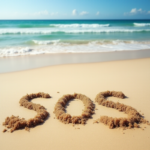When embarking on a sailing journey, “sailing safe” is a top priority for anyone, from seasoned mariners to first-time sailors. Whether you’re navigating familiar shores or venturing into open waters, preparation and caution are vital for an enjoyable and secure experience. This article will outline practical tips for sailing safely, covering pre-trip planning, essential gear, weather monitoring, and emergency preparedness.
1. Preparing Your Vessel for a Safe Sail
The first step in sailing safe is ensuring your boat is ready for the journey. Regular maintenance checks help identify potential issues before they become major problems. Here’s what to focus on:
- Inspect the Hull and Rigging: Check for cracks, damage, or any signs of wear. Ensure that all ropes and wires are securely in place.
- Engine and Fuel: Make sure the engine is in good working condition and that you have enough fuel for the trip, with an extra reserve for unexpected detours.
- Electrical Systems: Verify that lights, radio systems, and any other electrical components are operational.
- Safety Equipment: Confirm that life jackets, flares, fire extinguishers, and first aid kits are on board and easily accessible.
Pro Tip: Develop a pre-sail checklist to go over each time you set sail. This helps avoid missed steps that could compromise safety.
2. Stocking the Right Safety Gear
Having the correct gear on board is a must when it comes to sailing safe. Beyond the mandatory life vests, consider these crucial items:
- VHF Radio: A reliable communication tool, essential for contacting nearby vessels or the coast guard in emergencies.
- EPIRB (Emergency Position Indicating Radio Beacon): This device transmits your location to search and rescue services if activated.
- Navigation Tools: A combination of electronic GPS devices and traditional maps or nautical charts.
- Personal Locator Beacons (PLBs): Smaller than EPIRBs, these personal devices can be attached to a life jacket and activated if you fall overboard.
Key Reminder: Test all electronic devices before each trip to ensure they are working properly and are fully charged.
3. Understanding and Monitoring Weather Conditions
Keeping an eye on weather forecasts is essential for planning a safe sailing trip. Sudden storms or unexpected weather changes can create dangerous conditions at sea. Here’s how to stay informed:
- Weather Apps and Marine Forecasts: Utilize tools like Windy, NOAA Weather Radio, or other marine-specific apps that provide real-time updates.
- Visual Cues: Learn to read the sky and sea. Dark clouds, a sudden drop in temperature, or increased winds can indicate an approaching storm.
- Plan for the Unexpected: If conditions are even slightly questionable, it’s better to err on the side of caution and reschedule your trip.
Sailing Insight: Experienced sailors always have a “Plan B” in case weather conditions worsen, including knowing the nearest safe harbor locations.
4. Emergency Drills and Crew Preparation
No matter how well-equipped your boat is, preparation can only go so far without training. Familiarize your crew with essential safety drills:
- Man Overboard Procedure: Practice this drill frequently. Assign roles so that everyone knows what to do if someone falls overboard.
- Fire Response: Demonstrate how to use fire extinguishers and discuss the steps to take in case of a fire.
- Distress Signals: Make sure everyone knows how to deploy flares or use a radio to call for help.
Pro Sailing Tip: Regular safety drills instill confidence and reduce panic during real emergencies.
5. Sailing Safe at Night
Nighttime sailing adds complexity to navigation. To stay safe, ensure your boat is properly lit with navigation and anchor lights. Equip your vessel with:
- Spotlights and Headlamps: For additional illumination.
- Radar and AIS (Automatic Identification System): These help detect other vessels and potential hazards even in low-visibility conditions.
- Proper Watch Schedules: Assign shifts to maintain vigilance during night hours. Fatigue is a common risk factor, so rotation helps keep everyone alert.
Advice for Night Voyages: Reduce your speed and maintain a safe distance from other boats and shorelines.
6. Learning Basic First Aid and Survival Skills
When sailing, access to emergency medical services is limited. Knowing basic first aid and CPR can be life-saving. It’s also beneficial to carry a survival guide that covers:
- Treatment for Hypothermia: Important for cold water emergencies.
- Wound Care: Essentials like bandages, antiseptic, and splints should be readily available.
- Emergency Food and Water: Pack non-perishable food and sufficient drinking water to last longer than your planned journey.
7. Final Safety Checks Before You Depart
Before setting sail, complete these last-minute checks:
- Weather Recheck: Verify there are no new weather warnings.
- Fuel and Engine Test: Run the engine for a few minutes to ensure it starts without issues.
- Communication Devices: Confirm all radios and emergency beacons are functioning.
- Notify Someone on Land: Let a trusted contact know your sailing plan and estimated return time.
Sailor’s Tip: Having a designated “float plan” is a simple way to improve safety. This document outlines your trip details, ensuring rescuers know where to start looking if necessary.
Conclusion
Sailing safe is a combination of preparation, knowledge, and vigilance. By ensuring your boat is well-maintained, packing the right safety gear, staying updated on weather conditions, and training your crew in emergency procedures, you can greatly enhance your safety at sea. Embrace these practices and turn each trip into an adventure worth remembering for the right reasons.



